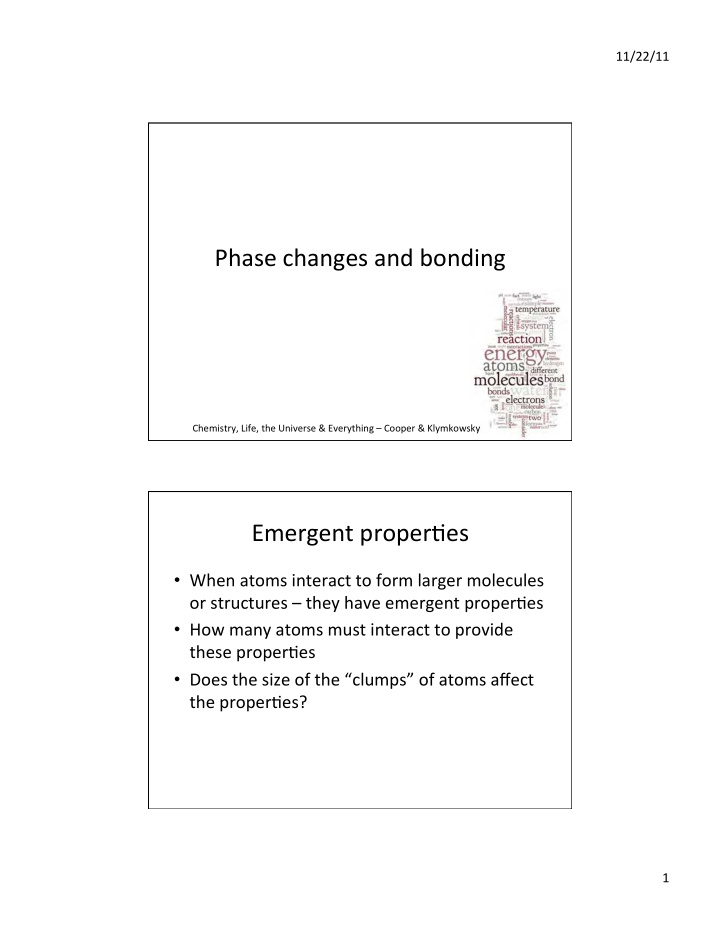



11/22/11 ¡ Phase ¡changes ¡and ¡bonding ¡ Chemistry, ¡Life, ¡the ¡Universe ¡& ¡Everything ¡– ¡Cooper ¡& ¡Klymkowsky ¡ Emergent ¡properCes ¡ ¡ • When ¡atoms ¡interact ¡to ¡form ¡larger ¡molecules ¡ or ¡structures ¡– ¡they ¡have ¡emergent ¡properCes ¡ ¡ • How ¡many ¡atoms ¡must ¡interact ¡to ¡provide ¡ these ¡properCes ¡ • Does ¡the ¡size ¡of ¡the ¡“clumps” ¡of ¡atoms ¡affect ¡ the ¡properCes? ¡ 1 ¡
11/22/11 ¡ nanopar&cles ¡ Gold ¡nano-‑parCcles ¡interact ¡ with ¡light ¡differently ¡ depending ¡on ¡the ¡size ¡of ¡the ¡ parCcle ¡ ¡ NanoparCcles ¡~ ¡1-‑ ¡100 ¡nm ¡ (many ¡biomolecules ¡fall ¡into ¡ this ¡range) ¡ ¡ They ¡have ¡different ¡ properCes ¡than ¡bulk ¡ materials ¡ ¡ Depend ¡on ¡surface ¡area ¡to ¡ size ¡raCo ¡ hUp://www.webexhibits.org/causesofcolor/9.html ¡ Discrete ¡vs ¡conCnuous ¡materials ¡ What ¡trends ¡or ¡paUerns ¡can ¡you ¡see ¡here? ¡ 2 ¡
11/22/11 ¡ Changes ¡of ¡state ¡ • To ¡go ¡from ¡solid ¡ à ¡liquid ¡ à ¡gas ¡phase ¡ requires ¡energy, ¡where ¡does ¡it ¡come ¡from? ¡ • To ¡go ¡from ¡gas à ¡liquid ¡ à ¡solid ¡phase ¡ releases ¡energy, ¡where ¡does ¡it ¡go? ¡ ¡ • What ¡is ¡the ¡energy ¡used ¡for? ¡(To ¡overcome ¡ aUracCons ¡between ¡parCcles) ¡ Effect ¡of ¡temperature ¡ • The ¡melCng ¡point ¡of ¡molecular ¡hydrogen ¡is ¡ 14K ¡ – What ¡is ¡making ¡the ¡molecules ¡sCck ¡together? ¡ • The ¡boiling ¡point ¡of ¡molecular ¡hydrogen ¡is ¡ ¡ ~20K ¡ – What ¡interacCon ¡is ¡overcome ¡when ¡H 2 ¡boils? ¡ • At ¡~6000K ¡molecular ¡hydrogen ¡dissociates ¡ – What ¡interacCon ¡is ¡overcome ¡at ¡6000K? ¡ 3 ¡
11/22/11 ¡ MelCng ¡and ¡boiling ¡ • When ¡a ¡substance ¡melts, ¡the ¡interacCons ¡ between ¡the ¡parCcles ¡have ¡to ¡be ¡overcome ¡– ¡so ¡ that ¡they ¡can ¡move ¡relaCve ¡to ¡each ¡other ¡(that’s ¡ what ¡allows ¡a ¡liquid ¡to ¡flow). ¡ • The ¡magnitude ¡of ¡the ¡melCng ¡point ¡provides ¡an ¡ esCmate ¡of ¡the ¡strength ¡of ¡the ¡interacCons ¡ between ¡parCcles. ¡ • The ¡mp ¡(and ¡bp) ¡of ¡Li, ¡Be, ¡B, ¡and ¡C ¡are ¡much ¡ higher ¡because ¡chemical ¡bonds ¡(rather ¡than ¡ intermolecular ¡interacCons) ¡are ¡broken ¡when ¡ these ¡substances ¡melt. ¡ What ¡is ¡the ¡difference ¡between ¡a ¡ covalent ¡bond ¡and ¡LDF ¡ • Covalent ¡bond ¡ • LDF/van ¡der ¡Waals ¡interacCon ¡ – Strong ¡(require ¡a ¡lot ¡of ¡ – RelaCvely ¡weak ¡ energy ¡to ¡break) ¡ – Caused ¡by ¡fluctuaCng ¡charge ¡ – Caused ¡by ¡aUracCon ¡of ¡ distribuCon ¡ electrons ¡from ¡one ¡atom ¡ – Increase ¡(predictably) ¡with ¡size ¡ to ¡nuclei ¡from ¡another ¡ of ¡electron ¡cloud ¡ atom ¡ – Present ¡between ¡all ¡molecular ¡ – Hard ¡to ¡predict ¡bond ¡ level ¡species ¡ strength ¡ – Between ¡separate ¡molecules ¡ – Present ¡only ¡when ¡atomic ¡ ¡ orbitals ¡interact ¡ construc&vely ¡ – Within ¡molecules ¡or ¡ networks ¡ 4 ¡
Recommend
More recommend